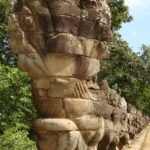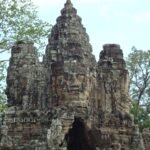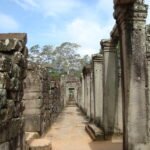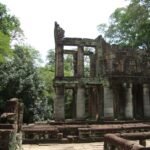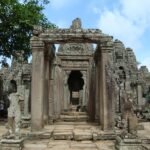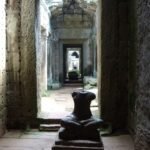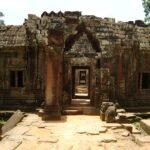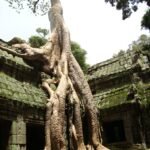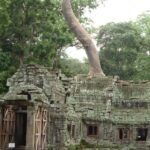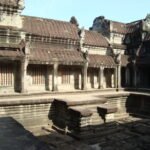Two Backpacks
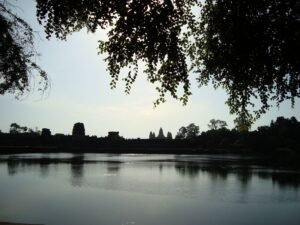
Chapter 14 - Mystical splendour of Angkor Wat
After witnessing the horrors of S21 and Choeng Ek, we’re happy to be on the road again.
Our six-hour bus journey from Phnom Penh to Siem Reap is tiring. Our travel lethargy is disrupted when our bus hits an ox that decides to cross the road at the same moment we pass by.
There’s much angry, rapid-fire chatter as the driver descends from our bus to inspect his vehicle and the animal. Other male passengers follow, not to assist but to stand and gawp at the poor beast.
‘You okay?’ asks Ron. The driver’s quick reaction prevented the bus from leaving the road, but the speed with which the bus stopped caused minor injuries to a number of passengers.
‘I’m fine. Just a bit shaken up. How about you?’
‘The same. The stop caused a bit of whiplash to my neck, but I don’t think there’s any damage done,’ replies Ron flexing his head to one side and then the other just to make sure.
We’re lucky. A few of the other passengers didn’t fare so well. A woman at the front of the bus has a gashed forehead, while another has a broken arm.
Outside, the ox, after a few prods and kicks, has revived. It hauls its large frame up onto four slightly wobbly legs, shakes itself from head to tail and then saunters off into the bush without a backward glance at us or the bus.
Passengers find their seats again, and our driver, although still a little shaken, clambers into his seat, fires up the engine, and we set off once more.
Our only other stop is when we pause at the next town to deposit the two injured passengers to waiting medics. The rest of our journey is uneventful.
We’re met at the Siem Reap bus station by a tuk-tuk driver holding a placard with my name.
‘Miss Sandi? I’m from Rosy Guest House. My name is Mr Chann Tha. I will be pleased to show you Angkor Wat, if you need a guide.’
Smartly dressed in a white cotton shirt and grey flannel trousers, I reckon Mr Tha is in his mid-thirties. I look over at Ron but get no indication of whether he’s prepared to accept Mr Tha’s offer.
‘Can you take us to the guest house first? We’ve had a long trip. I’d like to settle in before we decide about a guide,’ I reply.
Mr Tha isn’t fazed by this and loads our bags onto the back of the tuk-tuk while Ron and I wedge ourselves onto the narrow, padded seat beneath a bright green and gold canopy.
The fifteen-minute ride to the guest house lets us glimpse the city of Siem Reap, the second largest in Cambodia. There’s a heavy French-colonial influence in many of the older buildings that stand proudly between modern shopping malls.
Our guest house is full of backpackers like Ron and me. I can hear French and German voices as we enter the reception area. Mr Tha helps offload our packs and carries them to the front desk.
Ron and I have a brief discussion about hiring our tuk-tuk driver before I make an executive decision.
‘Can you meet us here at nine-thirty tomorrow morning?’ I ask.
Mr Tha’s happy. He smiles, shakes our hands and agrees to meet us at the arranged time.
We check in and make our way to our first-floor room. It’s delightful, with clean linen and a small balcony overlooking the street. Ron’s happy, too – there’s good WiFi.
Mr Chann Tha is waiting for us the following morning. Ron and I squeeze onto the back seat of the tuk-tuk, and we set off for Angkor Wat, the largest religious monument in the world.
Becky had advised we buy a three-day pass due to the enormity of the site. At the entrance, I take her advice. Anticipation builds the nearer we get. I’d read so much about Angkor Wat and admit to being envious when I heard Becky describe her experiences there. Now it’s my turn!
Our first glimpse is of the moat and outer wall. Behind the grey stones are the dark shadowed images of the temples, the vista reflected in the still waters surrounding the area.
Our guide suggests visiting Angkor Thom and the Royal Palace on our first day. We continue to the south entrance. There Mr Tha parks the tuk-tuk, and we walk to Angkor Thom, the last capital of the Khmer people. At its centre lies the imposing golden temple of Bayon.
‘Did you know that people thought Angkor Thom was a microcosm of the universe? And that the temple of the Bayon, located at the centre of the four axes, is a symbolic link between heaven and earth?’ Chann Tha asks.
We wander through the site, taking photos. Our guide proves highly knowledgeable, explaining the history of many of the carvings within Angkor Thom. He’s also had the forethought to bring cold water to quench our thirst and umbrellas to protect us from the sun.
With the day’s heat building, we return to our tuk-tuk and drive to the site of the Royal Palace.
‘This building is supposed to be older than the city of Angkor Thom, around the thirteenth century,’ Mr Tha tells us as we stand in the shade of one of many trees around the site. ‘Only a few buildings remain; most were built on wood frames and have collapsed over time.’
While picturesque, the stone remains of this once-great palace stand stark against the beauty of the jungle. My thoughts drift to imagining life in this lost civilisation.
Ron’s saying something to me. I haven’t heard a word he’s said.
‘Come on, Chann is taking us to the Terraces of the Elephants and Leper King,’ he repeats, taking my hand.
Our final visit of the day is to Preah Khan and the temple Ta Prohm, eight kilometres from Angkor Wat.
We leave our tuk-tuk and walk the well-worn path through the jungle to the entrance. Stone figures, many missing their heads, line the causeway leading us to the temple.
The imposing grey stone building, built in the twelfth century, has a large flagstone path leading to the entrance. I’m struck by the similarity between the stately country houses of Somerset, with their stone porticos and high windows on either side.
Ron and I follow our guide through the east entrance. There, looking like some alien beings, stand two trees perched on top of the moss-covered buildings. The sight stops me in my tracks.
The trees tower above us, but it’s not their height that has me enthralled. Massive roots twist and turn their way earthward in every direction, pushing through walls, seeking stability from the temple’s ancient stones.
‘It’s like something from The Day of the Triffids!’ exclaims Ron. ‘Look at the size of that root! It’s enormous!’
I look in the direction of Ron’s outstretched arm. Over the decades, the root in question has grown across the roof of one of the buildings and is now halfway down the side of the building’s intricately carved stone windows.
‘It looks like an elephant’s trunk,’ I exclaim. My imagination is beginning to kick in as I envisage these green-grey monster roots entwining us in their grasp, imprisoning us for eternity.
I give myself a mental shake and follow Ron and Chann as they weave through the site to the inner temple. Many buildings are in a state of disrepair, but this doesn’t detract from their beauty.
Chann takes us to see one of the remaining stupas and the statue of Jayedevi, one of Jayavarman VII’s wives, before leading us to Jayatataka Baray, an old landing spot with beautiful views over the reflective waters and the jungle beyond. Ron and I find a spot to sit and watch as the sun slips behind the dark outline of temples and jungle, their images reflected in the still waters of the lake.
We’re up early the following morning. Chann is due to pick us up at five-thirty to take us to Angkor Wat.
I’ve already peeked out of the window, and while there are clouds, the sky is lightening, heralding what I hope will be another sunny day.
With a couple of croissants each and bottles of water stashed in our small packs, Ron and I clamber into Chann’s tuk-tuk. I glance at the sky.
‘Don’t worry, Miss Sandi, we’ll be there before sunrise,’ Chann informs me.
I sit back and enjoy watching the early morning bustle as we drive through the outskirts of the town. Women sweep the front stoops of their homes while children run and play, chasing squawking chickens. The men folk seem less inclined to help with the chores, instead choosing hammocks slung between nearby trees.
‘Looks like we’re not the only ones up early this morning,’ Ron comments as we join a line of idling tuk-tuks waiting to enter the site, all with tourists eager to see the sun rise over Angkor Wat. The queue moves forward relatively quickly, and we’re soon on our way again.
Chann stops under the overhanging branches of trees that line the moat surrounding Angkor Wat.
‘We have fifteen minutes to wait,’ he announces before walking off to one of the nearby stalls, to return a few minutes later with three steaming cups of sweet, black coffee.
We share our croissants with Chann, our impromptu breakfast all the more enjoyable for the serenity of the view before us.
‘Here comes the sun,’ exclaims Chann. As if on cue, a ray of sunshine lights the eastern sky above the dark outline of Angkor Wat. The scene changes as the sun rises, throwing a golden glow over the temples and the shimmering water.
It’s as if everyone is spellbound by the spectacle. All I can hear is the murmur of voices and the clicking of cameras as we and those around us snap images of Angkor Wat at sunrise.
Once the sun is above the temple, tuk-tuk engines kick into life, conversations begin again, and the gathered crowds surge toward the entrance to the famous temple.
We follow Chann across the bridge that spans the moat.
The site is vast. We only get to see part of it, including the four inner walls that depict the wars fought between the gods and armies of the kings. The heat and the previous day’s migraine take their toll. By midday, I’m done.
‘I’m sorry.’ I apologise to both Ron and Chann.
‘Don’t worry. I’m templed out anyway,’ retorts Ron, pleased I’ve cut short our trip. ‘Let’s get back and relax for a while.’
At the guest house, we give Chann a generous tip and thank him for his knowledgeable tours and his kindness in providing water, umbrellas and humour to our visit to Angkor Wat.
We’re on the move again tomorrow, returning first to Phnom Penh for the night and then to Sihanoukville for a few days of well-deserved rest and recuperation on the Cambodian coast.

